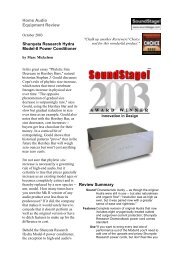Download Model 5 brochure
Download Model 5 brochure
Download Model 5 brochure
Create successful ePaper yourself
Turn your PDF publications into a flip-book with our unique Google optimized e-Paper software.
sequential amplifier stages are used. Most modern<br />
high performance amplifiers use as many as seven<br />
cascaded stages. In addition the input signal does<br />
not only have to pass through several serial amplifier<br />
stages but most of the amplifiers use several<br />
power transistors in parallel to achieve a higher<br />
power output. In some “monster” amplifier designs<br />
up to 20 power transistors are switched in parallel.<br />
Serial and parallel signal processing have two<br />
major disadvantages. First of all any transistor –<br />
even highest-grade versions produce distortions.<br />
The more stages are used, the higher the distortions<br />
of the circuitry become. And theses “distortions”<br />
do not only add to each other, but multiply together<br />
as well. This is because every stage amplifies the<br />
distortions of the previous stage and modulates its<br />
own distortions on top of it!<br />
The second problem refers to the speed in which<br />
the feedback readjusts the problems at the output.<br />
The more stages an amplifier has, the slower the<br />
“forward” processing of the signal is, and the bigger<br />
the lateral off-set between the input and the<br />
output of the amplifier becomes. In practice this is<br />
called “slow forward amplification”. In the laboratory,<br />
distortion occurring during the amplification<br />
of the signal can be eliminated with a high feedback,<br />
but these corrections only become active due<br />
to the slow forward amplification with a subsequent<br />
time delay. This is to say that the corrections do<br />
happen with inertia and thus probably at a moment<br />
in which the original distortion has already disappeared.<br />
The feedback thus generates an inevitable<br />
new distortion, which is again amplified by the<br />
forward processing and is again corrected by the<br />
feedback etc. etc. The delay between the start and<br />
the elimination of the problem permanently generates<br />
new distortions. The amplifier gets into a stage of<br />
permanent oscillation and has more work fixing<br />
itself generated problems than with processing the<br />
original signal. Fortunately these self-produced<br />
distortions are mostly of linear nature. This is to say<br />
that the amplifier circuit corrects the same distortion<br />
all over again, regardless of the music signal. The<br />
described time delay when correcting these self<br />
produced linear distortions, in practical operation<br />
is, subjectively not so critical.<br />
Contrary to above, this problem is much more serious<br />
with a speaker connected, e.g. a varying<br />
complex load. Any speaker system is an unknown,<br />
variable disturbance which is continously inducing<br />
interferences into the amplifier. These electro-magnetic-forces<br />
are induced by electrical currents of the<br />
speaker drivers and these are fed back to the amplifier<br />
as variable error voltages. The feedback detects<br />
these error voltages and tries to eliminate<br />
them. As these electro-magnetic-forces permanently<br />
change with frequency and level of the music, the<br />
correction occurs with a time delay, so the correction<br />
will logically always be too late. For an experienced<br />
listener it is relatively easy to distinguish between<br />
the relatively harmless self-generated amplifier<br />
distortions and feedback distortions induced by the<br />
speaker. Mostly in operation this problem shows up<br />
as a “slow”, sometimes “hard” midrange/treble<br />
response and a reduced resolution of the system.<br />
Furthermore the delay of the feedback will cause a<br />
permanent shifting of the phase of the signal, which<br />
shows up as harmonic distortions. This results in a<br />
“specific” tonality of the amplifier with reduced<br />
sound staging and naturalness of the sound.<br />
THE AVANTGARDE PHILOSOPHY<br />
Avantgarde Acoustic loudspeakers are known to<br />
react very quickly to any variation of the music<br />
signal and to transform these into audible sound.<br />
“With our speakers we use the horn technology to<br />
make the forward acceleration and transient response<br />
as fast as possible. What goes in, should<br />
come out,” describes Matthias Ruff. Different to<br />
most manufacturers who optimise the decay time of<br />
their speakers (waterfall diagram) the company<br />
from Lautertal regard the fast forward signal processing<br />
as the main advantage of their speaker<br />
designs. “Who cares about the second distortion, if<br />
the first distortion has not even been detected. Most<br />
speakers are purposely made slow and inert, only<br />
to make the waterfall graphs look good in reviews.<br />
It is so obvious: the less I let pass through from the<br />
front, the better it looks from behind. But this doesn’t<br />
mean that you have a good speaker. It is like reducing<br />
the maximum speed of car drastically only to<br />
improve the breaking distance,” explains the<br />
Avantgarde designer furiously. And with multi-stage<br />
amplifiers having high forward gain and strong<br />
feedback Matthias Ruff is seeing the same problems.<br />
“In the HGHF-principle you purposely put<br />
up with errors during the forward amplification,<br />
because later at the end you can flatten everything<br />
with a high feedback”. In other words these designers<br />
do not even try to prevent distortion in the<br />
early gain stages, but count on heavy reprocessing<br />
of the signal at the end. “If I already falsify the signal<br />
at the front end, I can later correct as much as I<br />
want, the information simply gets irretrievably lost”.


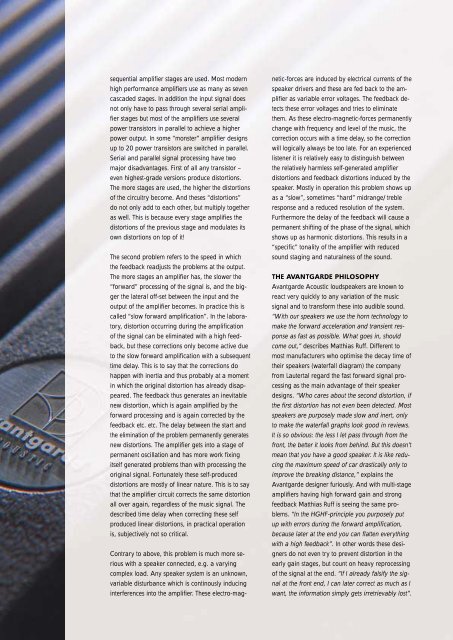
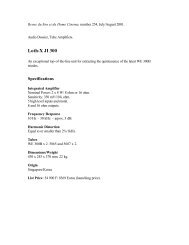


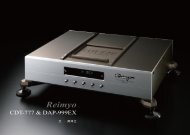


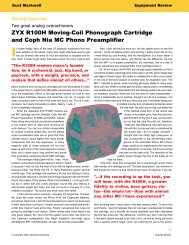
![DAP-999 EX Limited [pdf] - Audio Note Singapore](https://img.yumpu.com/27191044/1/190x253/dap-999-ex-limited-pdf-audio-note-singapore.jpg?quality=85)

![Harmonix CS-120 Improved-Version [pdf]](https://img.yumpu.com/24411255/1/184x260/harmonix-cs-120-improved-version-pdf.jpg?quality=85)
